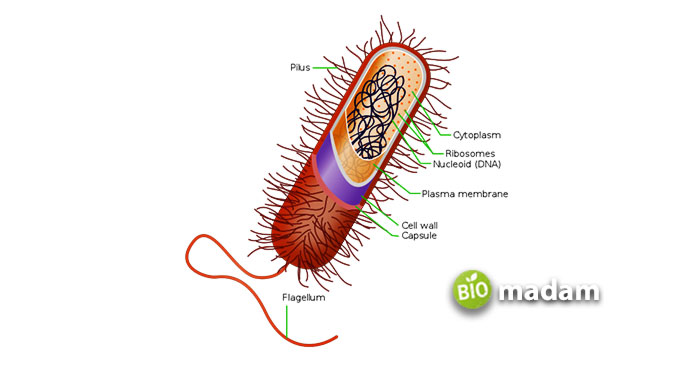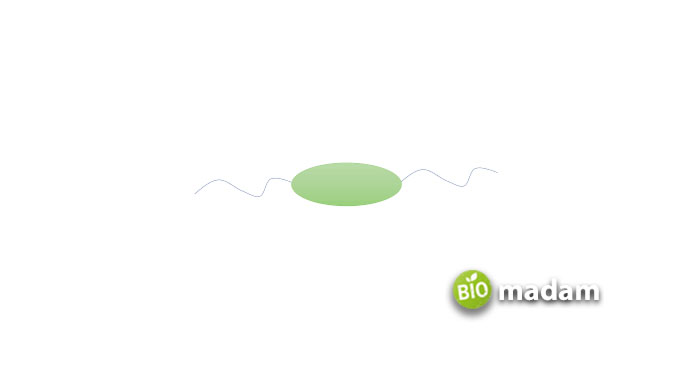Cells are the fundamental units of life for all living organisms. Cells of different living organisms have more or less the same components. Prokaryotic and eukaryotic cells have some differences in their components. All these components perform their defined functions. Cell mobility is an important function of most cells. Many single-celled organisms and some advanced organisms use flagella to move. It helps them to find and get food, or to escape danger.
The flagella found in eukaryotes and prokaryotes are different from each other in their structure and mechanism. Bacterial flagella help beneficial bacteria to move into the organism, whereas flagella of disease-causing bacteria help them to spread infection. Most functions of the flagella are the same in both eukaryotes and prokaryotes. Here, we shall discuss everything about the flagella found in prokaryotic cells, their structure, functions, and types.
What is Flagella?
Flagella is a hair-like structure found in eukaryotes and prokaryotes. This organelle is present on the cell surface and used for locomotion. The word ”flagellum” comes from the Latin word ”whip” referring to the movement of flagella. Flagella also acts as the sensory organ of the body and is used to detect changes in temperature and ph. Organisms can detect danger with flagella.
What is the Structure of Prokaryotic Flagella?
The flagellum structure in eukaryotic and prokaryotic cells is different, as expected. Even within prokaryotic cells, the flagella of bacteria and archaea are different. However, the basic structure of flagella is the same for all organisms. The following are the basic structures found in the flagella:
Filament
It is a hollow tube attached to the hook. filament is composed of a protein called ‘’flagellin.’’
Hook
A hook is a short and curved tubular structure responsible for connecting the body to the filament. It is composed of hook protein subunits.
Body
The basal body has a rod shape consisting of a series of rings. It is the only part of the flagella present within the cell membrane. It connects to the hook which further connects to the filament.

Flagella Functions in Prokaryotic Cells
Following are some of the main functions of flagella:
Locomotion
The main function of flagella in prokaryotes is locomotion as it allows the movement of the organism. The prokaryotic flagellum forms a corkscrew filament and spins or swims through the liquid. It is responsible for taking the organism to favorable environments.
Sensation
Another important function of flagella is its role in producing sensations. Flagella acts as an important sensory organ of microorganisms. It can sense any danger coming its way or present in the surroundings and can run to save itself.
Exchange of Materials
Flagella is involved in the exchange of materials. As they are present on the cell surface, they can regulate the entry and exit of materials. It allows the nutrients to enter the cell and transports the waste outside the cell.
Other Common Functions
There are some other common functions of flagella as well. It is responsible for conducting signal transduction of the cell. Flagella is also used by the organism to stick to different surfaces. Thus, it has a role in adhesion. They have the capability to act as virulence factors. By forming these virulence factors, they can easily invade the host tissues and develop within them. Most bacteria use their flagella to spread diseases and infections in humans. Flagella also functions in the formation of biofilms.
Mechanism of Flagella Movement in Prokaryotic Cells
A series of rings surrounded by proteins attach the flagellum to the cell wall and cell membrane. A proton gradient is created across the lowest rings with the help of a proton pump. This electrochemical gradient generates a proton motive force responsible for the rotational movement of the flagella. Due to this proton motive force, the protons diffuse along the lowest ring boundary, and the ring spins while the attached filament hook rotates. When this rotation is in one direction, the bacteria move forward in a controlled manner. If this rotation is in the other direction, then the bacteria moves randomly in a tumbling manner. This combination of bacterial motility and a change of direction allows the bacteria to cover a greater distance.
Types of Flagella Found in Prokaryotic Cells
There are four main types of flagella found in prokaryotic cells:

Monotrichous
Monotrichous flagella have a single flagellum located at one end of the organism.
Examples: Vibrio cholera, Campylobacter spp., Caulobacter crescentus, etc.
Amphitrichous
In this type, a single flagellum is present on both sides of the organism.
Examples: Alkaligens faecalis, Campylobacter jejuni, Rhodospirillum rubrum, and Magnetospirillum.
Lophotrichous
This type has numerous flagella on one end of the organism.
Examples: Spirillum, Pseudomonas fluorescens, etc.
Peritrichous
This type has flagella present all over the organism’s body.
Examples: Salmonella typhi, Escherichia coli, Bacillus subtilis, and Klebsiella.
Difference between Eukaryotic Flagella and Prokaryotic Flagella
| Eukaryotic Flagella | Prokaryotic Flagella |
| Tubulin protein present | Flagellin protein present |
| ATP driven movement | Proton-driven movement |
| Blending movement type | Rotatory movement type |
| They are located in the plasma membrane | They are located outside plasma membrane |
| The body bears rootlets | The body bears rings |
Conclusion
Cell motility is an important function of the cell. The primary organelle responsible for cell motility is the flagella which are hair-like structures found on the cell surface. The main function of flagella is the movement of prokaryotic or eukaryotic organisms. However, their functions, structures, and numbers are different in these two types of cells. Prokaryotic flagella consist of a body, filament, and hook. Other than that, it is made of flagellin protein. The functions of prokaryotic flagella include sensation, adhesion, locomotion, signal transduction, and spreading infection.
Frequently Asked Questions (FAQs)
Here are a few frequently asked questions about flagella:
What is the number of flagella found in prokaryotes?
Prokaryotes can have one or more than one flagella.
What is the size of flagella found in prokaryotic cells?
The usual size of flagella is 10–30 nm in diameter and 5–20 μm in length.
What is the difference between cilia and flagella?
Both cilia and flagella are used for locomotion. However, cilia are shorter and higher in number as compared to flagella. Movement with cilia can be faster than with flagella.
What is the difference between pili and flagella?
The main difference between pili and flagella is the difference in function. Pili in prokaryotes help in attachment, whereas flagella are there for locomotion. Pili are comparatively less rigid than flagella.

Anna has completed her degree in Pharmacy from the University of Hawaii. She is serving as a research assistant in a pharmaceutical company. She had a great interest in writing blogs, traveling to different parts of the US, and trying delicious recipes in her spare time.

